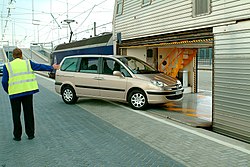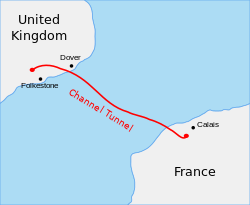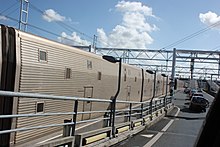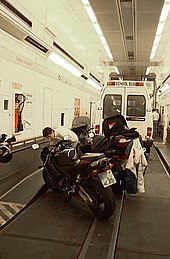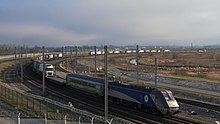
The Channel Tunnel, also known as the Chunnel, is a 50.46-kilometre (31.35 mi) underwater railway tunnel that connects Folkestone with Coquelles beneath the English Channel at the Strait of Dover. It is the only fixed link between the island of Great Britain and the European mainland. At its lowest point, it is 75 metres (246 ft) deep below the sea bed and 115 metres (377 ft) below sea level. At 37.9 kilometres (23.5 mi), it has the longest underwater section of any tunnel in the world, and is the third longest railway tunnel in the world. The speed limit for trains through the tunnel is 160 kilometres per hour (99 mph). The tunnel is owned and operated by the company Getlink, formerly "Groupe Eurotunnel".

A railroad car, railcar, railway wagon, railway carriage, railway truck, railwagon, railcarriage or railtruck, also called a train car, train wagon, train carriage or train truck, is a vehicle used for the carrying of cargo or passengers on a rail transport network. Such cars, when coupled together and hauled by one or more locomotives, form a train. Alternatively, some passenger cars are self-propelled in which case they may be either single railcars or make up multiple units.

VR-Group Plc, commonly known as VR, is a government-owned railway company in Finland. VR's most important function is the operation of Finland's passenger rail services with 250 long-distance and 800 commuter rail services every day. With 7,500 employees and net sales of €1,251 million in 2017, VR is one of the most significant operators in the Finnish public transport market area.

Getlink, formerly Groupe Eurotunnel, is a European public company based in Paris that manages and operates the infrastructure of the Channel Tunnel between England and France, operates the Eurotunnel Shuttle train service, and earns revenue on other trains that operate through the tunnel.

A loading gauge is a diagram or physical structure that defines the maximum height and width dimensions in railway vehicles and their loads. Their purpose is to ensure that rail vehicles can pass safely through tunnels and under bridges, and keep clear of platforms, trackside buildings and structures. Classification systems vary between different countries, and gauges may vary across a network, even if the track gauge is uniform.

The Channel Tunnel fire of 18 November 1996 occurred on a train carrying Heavy Goods Vehicles (HGVs) and their drivers through the Channel Tunnel from France to the United Kingdom (UK). The fire was seen on the train as it entered the tunnel and, in line with the policy at the time, an attempt was made to drive to the UK where the fire would be dealt with. However, after an indication of a serious problem with the train, the driver stopped at 21:58 CET, 19 kilometres (12 mi) into the tunnel. The locomotive and passenger coach were rapidly enveloped in thick smoke, and the locomotive lost power. Reconfiguration of the tunnel ventilation systems was delayed, but by 22:30 all passengers and crew were safe, in the service tunnel, with minor injuries.

The East Rail line is one of ten lines of the Mass Transit Railway (MTR) system in Hong Kong. It used to be one of the three lines of the Kowloon–Canton Railway (KCR) network. It was known as the KCR British Section (九廣鐵路英段) from 1910 to 1996, and the KCR East Rail (九廣東鐵) from 1996 to 2007. East Rail was the only railway line of the Kowloon-Canton Railway Corporation (KCRC) following the closure of the Sha Tau Kok Railway and before the construction of KCR West Rail.

Auto Train is an 855-mile (1,376 km) scheduled daily train service for passengers and their automobiles operated by Amtrak between Lorton, Virginia, and Sanford, Florida. Auto Train is the only motorail service in the United States.

The British Rail Class 92 is a dual-voltage electric locomotive, which can run on 25 kV AC from overhead wires or 750 V DC from a third rail. It was designed specifically to operate services through the Channel Tunnel between Great Britain and France. Eurotunnel indicates the Class 92 locomotive as the reference for other locomotives which railway undertakings might want to get certified for usage in the Channel tunnel.

Rail freight transport is the use of railroads and trains to transport cargo as opposed to human passengers.

The Eurotunnel Class 9 or Class 9000 are six-axle high-power Bo′Bo′Bo′ single-ended electric locomotives built by the Euroshuttle Locomotive Consortium (ESCL) of Brush Traction and ABB. The class was designed for and is used exclusively to haul the Le Shuttle road vehicle services through the Channel Tunnel.

A horse-drawn vehicle is a mechanized piece of equipment pulled by one horse or by a team of horses. These vehicles typically had two or four wheels and were used to carry passengers and/or a load. They were once common worldwide, but they have mostly been replaced by automobiles and other forms of self-propelled transport.
The Night Ferry was an international boat train from London Victoria to Paris Gare du Nord that crossed the English Channel on a train ferry. It ran from 1936 until 1939 when it ceased due to the onset of World War II. It resumed in 1947, ceasing in 1980. It was operated by Compagnie Internationale des Wagons-Lits until 1977 and then British Rail.

In rail transportation, a rolling highway or rolling road is a form of combined transport involving the conveying of road trucks by rail, referred to as Ro-La trains. The concept is a form of piggyback transportation.
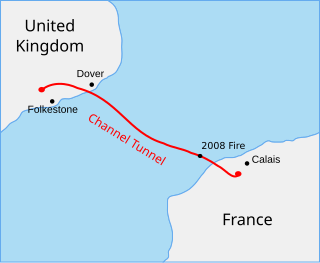
On 11 September 2008, a France-bound Eurotunnel Shuttle train carrying heavy goods vehicles (HGVs) and their drivers caught fire while travelling through the Channel Tunnel. The fire lasted for sixteen hours and reached temperatures of up to 1,000 °C (1,830 °F).
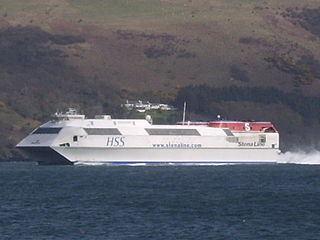
Accompanied combined transport is a form of intermodal transport, which is the movement of goods in one and the same loading unit or road vehicle, using successively two or more modes of transport without handling the goods themselves in changing modes. More specifically, accompanied combined transport is one of the two types of combined transport, which is intermodal transport where the major part of the journey is by rail, inland waterways or sea, and any initial and/or final legs carried out by road are as short as possible.

A car shuttle train, or (sometimes) car-carrying train, is a shuttle train used to transport accompanied cars (automobiles), and usually also other types of road vehicles, for a relatively short distance.
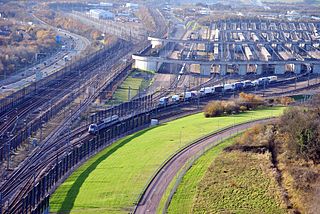
The Eurotunnel Folkestone Terminal is a railway terminal built for the transport of road-going vehicles on specially constructed trains through the Channel Tunnel. The terminal is one of two, with the Eurotunnel Calais Terminal located at Coquelles, near Calais.

The Eurotunnel Calais Terminal is a railway terminal built for the transport of road-going vehicles on specially constructed trains through the Channel Tunnel. The terminal is one of two, with the Eurotunnel Folkestone Terminal located at Cheriton, near Folkestone.

The Dover–Dunkerque train ferry was one of two regular rail freight train ferries that operated between the United Kingdom and Europe. The route connected the English port of Dover, with the French port of Dunkerque. After rationalisation of other Anglo-European train ferries, the Dover to Dunkerque sailing was the last to survive, though it ended its days on freight carryings only after the Night Ferry passenger service ended in 1980. The last Dover to Dunkerque wagon-freight ferry service became redundant upon the opening of the Channel Tunnel when freight was carried directly through the Channel Tunnel.
